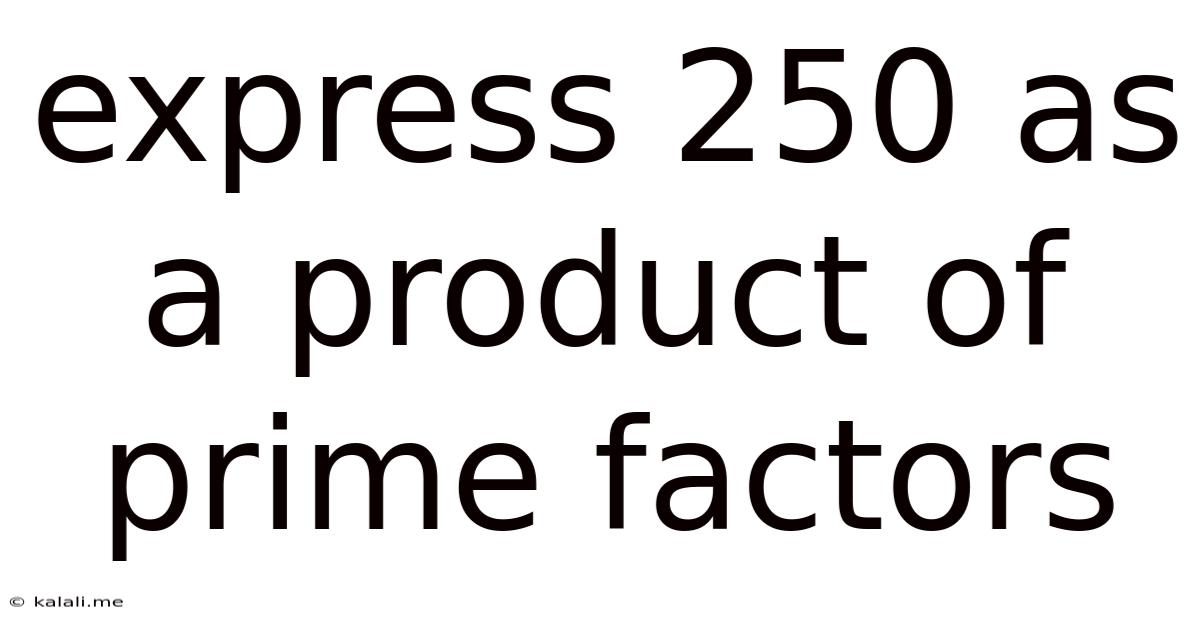Express 250 As A Product Of Prime Factors
Kalali
Jun 11, 2025 · 2 min read

Table of Contents
Expressing 250 as a Product of Prime Factors: A Step-by-Step Guide
Finding the prime factorization of a number is a fundamental concept in mathematics, crucial for various applications like simplifying fractions and solving algebraic equations. This article will guide you through the process of expressing 250 as a product of its prime factors, explaining the method clearly and concisely. This process is also known as prime factor decomposition. Understanding this will improve your skills in number theory and related mathematical concepts.
What are Prime Factors?
Before we begin, let's clarify what prime factors are. A prime number is a whole number greater than 1 that has only two divisors: 1 and itself. Examples include 2, 3, 5, 7, 11, and so on. A prime factorization is expressing a number as a product (multiplication) of its prime factors. Every composite number (a number that is not prime) can be uniquely expressed as a product of prime factors.
Finding the Prime Factors of 250
There are several ways to find the prime factors of 250. The most common method involves repeatedly dividing the number by the smallest prime number that divides it evenly until you are left with 1. Let's follow this method:
-
Start with the smallest prime number, 2: 250 is an even number, so it's divisible by 2. 250 ÷ 2 = 125.
-
Move to the next prime number, 3: 125 is not divisible by 3 (the sum of its digits, 1+2+5=8, is not divisible by 3).
-
Move to the next prime number, 5: 125 is divisible by 5. 125 ÷ 5 = 25.
-
Continue with 5: 25 is also divisible by 5. 25 ÷ 5 = 5.
-
We're left with 5: 5 is a prime number itself.
Therefore, the prime factorization of 250 is 2 x 5 x 5 x 5. This can be written more concisely as 2 x 5³.
Alternative Method: Factor Tree
Another visual method to achieve the same result is using a factor tree. This method is particularly helpful for larger numbers.
250
/ \
2 125
/ \
5 25
/ \
5 5
Following the branches of the tree, we arrive at the same prime factors: 2, 5, 5, and 5. Again, this simplifies to 2 x 5³.
Conclusion
Expressing 250 as a product of its prime factors results in 2 x 5³. This method, whether using repeated division or a factor tree, is a fundamental skill in number theory and has broader applications in various mathematical fields. Understanding prime factorization lays a solid foundation for more advanced mathematical concepts. Remember to always start with the smallest prime number and continue dividing until you are left with only prime numbers.
Latest Posts
Latest Posts
-
How Many Pounds Are In 900 Grams
Jul 01, 2025
-
How Long Does It Take To Drive 20 Miles
Jul 01, 2025
-
How Many Cups Is One Pound Of Pasta
Jul 01, 2025
-
How Many People Does A Gallon Of Tea Serve
Jul 01, 2025
-
How Many 750 Ml In A Gallon
Jul 01, 2025
Related Post
Thank you for visiting our website which covers about Express 250 As A Product Of Prime Factors . We hope the information provided has been useful to you. Feel free to contact us if you have any questions or need further assistance. See you next time and don't miss to bookmark.